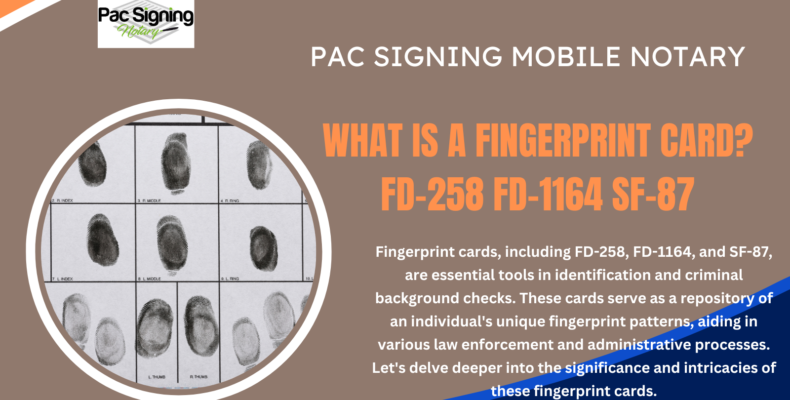Fingerprint cards, including FD-258, FD-1164, and SF-87, are essential tools in identification and criminal background checks. These cards serve as a repository of an individual’s unique fingerprint patterns, aiding in various law enforcement and administrative processes. Let’s delve deeper into the significance and intricacies of these fingerprint cards.
Introduction to Fingerprint Cards
Fingerprint cards, often referred to as fingerprinting forms, are standardized documents used to collect and record fingerprints for identification purposes. These cards are employed by law enforcement agencies, government institutions, and employers for a multitude of reasons, including criminal background checks, employment screening, and security clearances.
What is FD-258?
Understanding FD-1164
Overview of SF-87
Who Needs a Fingerprint Card?
Fingerprint cards are required by various individuals and organizations for different purposes:
Job Applicants: Many employers, especially those in sectors such as government, law enforcement, healthcare, and finance, may request fingerprint cards as part of the application process.
Government Agencies: Government entities, including federal, state, and local agencies, often require fingerprint cards for background checks, security clearances, and licensing purposes.
Volunteers: Individuals volunteering in positions that involve working with vulnerable populations, such as children or the elderly, may need to undergo fingerprinting for screening purposes.
Immigrants: Fingerprint cards may be required as part of the immigration process, particularly for individuals applying for visas, residency, or citizenship.
Security Clearance Holders: Individuals holding or seeking security clearances, especially in government or defense-related roles, may need to submit fingerprint cards for periodic reinvestigations.
Professional License Applicants: Certain professions, such as healthcare providers, educators, and real estate agents, may require fingerprinting as part of the licensure process.
What Are The Advantages Of Fingerprint Card:
Fingerprint cards offer several advantages over other forms of identification and background verification methods:
Unique Identification: Fingerprint patterns are unique to each individual, making them an extremely reliable form of identification. This uniqueness minimizes the risk of identity theft or fraud.
Permanent Characteristics: Unlike other forms of identification, such as ID cards or passwords, fingerprints remain constant throughout a person’s life. This permanence ensures long-term accuracy and reliability.
Difficult to Forge: Fingerprint impressions are difficult to replicate, making it challenging for individuals to falsify their identity or manipulate background check results.
Legal Admissibility: Fingerprint evidence is widely accepted in legal proceedings and can be used to establish identity, link suspects to crimes, and verify individuals’ backgrounds.
Efficiency: Fingerprinting is a relatively quick and non-invasive process, requiring minimal time and resources compared to other forms of identification verification.
Comprehensive Background Checks: Fingerprint cards allow for comprehensive background checks by enabling access to criminal databases and other records that may not be accessible through other means.
Standardization: Fingerprint cards such as FD-258 provide a standardized format for collecting and recording fingerprint data, ensuring consistency and compatibility across different agencies and jurisdictions.
In summary, fingerprint cards offer a highly reliable, efficient, and standardized method of identification and background verification, making them indispensable tools for various individuals and organizations.
Purpose of Fingerprint Cards
Fingerprint cards serve a dual purpose: identification and verification. They provide a reliable means of establishing an individual’s identity by comparing their fingerprint patterns against existing records. Additionally, these cards aid in verifying an individual’s criminal history and background, facilitating informed decision-making in various contexts.
History of Fingerprinting
The use of fingerprints for identification dates back thousands of years, but it wasn’t until the late 19th century that modern fingerprinting techniques emerged. Pioneered by Sir Francis Galton and later refined by Sir Edward Henry, fingerprinting gained widespread acceptance as a highly accurate method of identification. Today, fingerprinting technology continues to evolve, with digital systems enhancing efficiency and accuracy.
Usage in Background Checks
Fingerprint cards play a crucial role in background checks conducted by employers, government agencies, and law enforcement entities. By cross-referencing fingerprint impressions with criminal databases, these checks help assess an individual’s suitability for employment, licensure, or access to sensitive information.
Process of Fingerprinting
Fingerprinting typically involves the ink-and-paper method or digital scanning, depending on the equipment available and the requirements of the requesting agency. In the ink-and-paper method, the individual’s fingers are inked and then rolled onto the fingerprint card in specific patterns. Digital scanning, on the other hand, captures high-resolution images of the fingerprints directly onto a computer system.
Faq’s
Are fingerprint cards mandatory for all background checks?
Fingerprint cards are typically required for certain types of background checks, particularly those involving federal employment or security clearances.
Can I submit digital fingerprints instead of ink-and-paper cards?
Many agencies now accept digital fingerprints captured through live scan technology, offering a more convenient and efficient alternative to traditional ink-and-paper cards.
What should I do if there are errors on my fingerprint card?
If you notice errors on your fingerprint card, notify the fingerprinting technician immediately to rectify the mistakes before submission.
How long does it take to process fingerprint submissions?
Processing times vary depending on the agency and the volume of submissions. Generally, it can take anywhere from a few days to several weeks to receive results.
Is fingerprinting a reliable method of identification?
Yes, fingerprinting is widely regarded as one of the most reliable methods of identification due to the uniqueness and permanence of fingerprint patterns.
Conclusion
In conclusion, fingerprint cards such as FD-258, FD-1164, and SF-87 play a vital role in identification, background checks, and security protocols. These standardized documents provide a reliable means of capturing and storing fingerprint data, facilitating various administrative and law enforcement functions. As technology continues to evolve, the future of fingerprinting promises even greater accuracy and efficiency in the realm of biometric identification.


